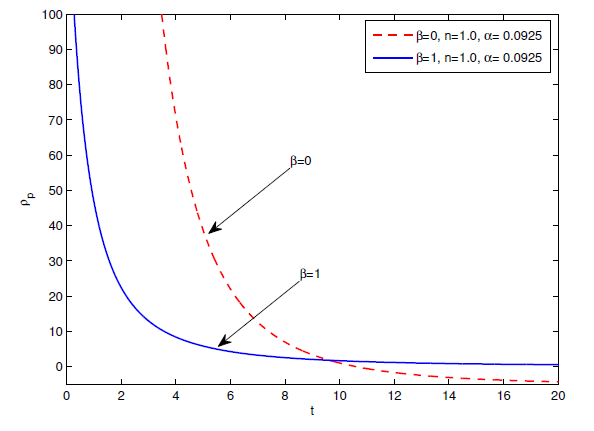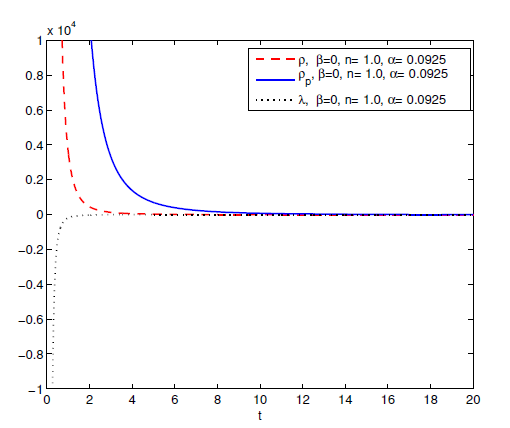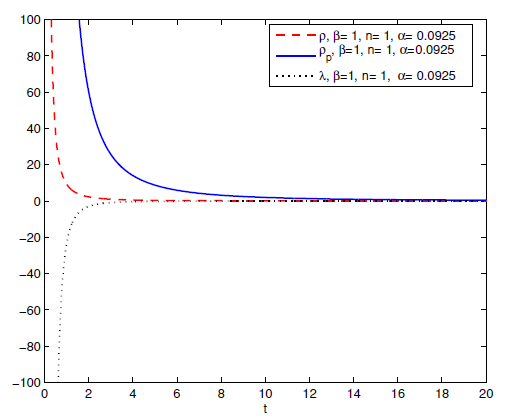The early universe is well described by homogeneous and an isotropic cosmological model as it has only ordinary matter and gravity. Here the ordinary matter means, a matter with non negative pressure and ordinary gravity is based on the four-dimensional Einstein-Hilbert action. Recently observational data indicates that the discrepancy arises at late time, when the age of the universe is some billions years. In this context the Friedmann-Robertson- Walker model is a unique correspondence between the expansion rate and the distance scale. Although general theory of relativity (GTR) is the most suitable theory for describing universe as a whole, but still there are some physical phenomena which are to be addressed by GTR. For this purpose there is a need either to modify the theory or to introduce alternate theory which is suitable to address the universe in all aspects. During the investigations of research findings it have been noticed that many alternate/modified theories of gravity were proposed by cosmologists as and when required. Among all the available alternative theories, the scalar-tensor Brans-Dicke theory (BD)1 of gravity is the most promising existing theory which has very effectively solves the problems of early time inflation and late time accelerating behaviour of the universe.2 According to BD theory, the gravitational constantis not a constant but it varies with space and time. The Brans-Dicke gravity also relates the gravitation constant G with scalar field ϕ
along with relation ϕ≅G−1
). The action principle for the Brans-Dicke gravity is given as
A=c316π∫ℜ(ϕR+ωϕ−1ϕνϕν)√−gd4x+Λ(1)
The variation of A
for small changes of gμν
leads to the field equations
Rμν−12gμνR=−8πc4ϕTμν−ωϕ2(ϕμϕν−12gμνϕδϕδ)−1ϕ(ϕ;μν−gμν□ϕ)(2)
where Rμν
is the Ricci curvature tensor, Tμν
is the energy momentum tensor, R
is the curvature scalar, ω
is the Brans-Dicke dimensionless coupling constant, T
is the trace of energy momentum tensor andis wave operator. Also the law of conservation of momentum may be expressed as
Tμν;k=0.(3)
Here ‘semicolon’ indicates co-variant derivative and ‘comma’ indicates partial derivatives.
Similarly, the variation of ϕ
leads to the following equation for ϕ
:
2ϕ□ϕ−ϕμϕμ=Rωϕ2.(4)
This latter equation can be simplified by substituting for R
from the contracted form of Equation (2). We finally get
□ϕ=8π(2ω+3)c4T,(5)
Equation (5) leads to the anticipated scalar wave equation for ϕ
with sources in matter. Because it contains a scalar field ϕ
in addition to the metric tensor gμν
, the BD theory is often referred to as the scalar-tensor theory of gravitation. BD theory is explained by a scalar function ϕ
and a constant coupling constant ω
, often known as the BD parameter. This can be obtained from general theory of relativity by letting ω→∞
and ϕ=constant
.3
The recent cosmic observational results authenticate the fact that our universe is undergoing a late-time accelerated expansion phase.4–8 To find the reason behind this late-time accelerating expansion of the universe is one of the most challenging problems in modern Cosmology and Astrophysics. We also believes that an unknown form of energy, commonly known as ’Dark Energy’ (DE), is responsible for this phase and it constitutes near about of the total universe. There are several proposals regarding DE, Cosmological Constant, Quintessence, Dark Energy9–14 being some of the competent candidates.
Viscosities play an important role in early stage evolution of the universe. Also it is well known that at early stage of the universe when neutrino decoupling occurred, the matter behaves like viscous fluid15 and coefficient of viscosity decreases with time as universe expands. Recently viscous string cosmological models have been studied by several authors16–26 in the context of general relativity, also many authors27–32 had discussed bulk viscous string cosmological models in BD theory. Very recently33–40 have been investigated the Bianchi type viscous cosmic string cosmological models in BD theory.
Motivated from above mention research work, in present paper, we had studied the bulk viscous string cosmological models with time dependentand cosmological constant in scalar-tensor BD theory of gravity. This paper has been divided in five different sections, including the introduction presented in section 1. In section 2, the metric and field equations governing the cosmological models are described, section 3 deals with exact solution of field equations. Section 4, the physical and kinematic behavior of the models has been presented in both the cases. Finally results, discussion and conclusions are summarized in last section i.e. section 5.
In present communication, we consider a spatially homogeneous and an anisotropic Bianchi type-III space-time metric as given below
ds2=−dt2+A2(t)dx2+e−2sxB2(t)dy2+C2(t)dz2,(6)
Here potential A, B and C are the functions of cosmic time
only and
is a constant.
The energy-momentum tensor
for a cloud of strings in the presence of bulk viscous fluid containing one dimensional cosmic string is given by
is the string tension density,
is effective pressure,
is the proper energy density for cloud strings with particles attached to them,
is the four-velocity vector and
is a unit space-like vector along the direction of string. The vectors
and
satisfy the conditions
,
.
Above
,
and
are the functions of cosmic time’t’ only. The particle density
of the configuration is given as
The string tension density
, may takes positive or negative values. It is also published by some authors41,42 that a negative value of
represents the universe filled with no string, whereas positive value of
indicate the universe filled with string particles. Here the effective pressure
may be define as
Where
is the bulk viscosity coefficient and
Hubble parameter.
For the metric given in equation (6) the field equation (2) may be expressed as:
Where an over head dot denote derivatives with respect to cosmic time
.
We may introduce cosmological parameters such as the spatial volume
, the Hubble’s parameter
, the expansion scalar
, the deceleration parameter
, the anisotropy parameter
and the shear scalar
for the metric (6) connected as,
Here
are the directional Hubble parameters in directions ofandaxis respectively.
Here
.
Now we required the solution of above stated field equations 11-16. This is presented in next section.
On integrating equation (15), we have
Here
is a constant of integration it can be taken as unity to avoid further complication, therefore
Putting
into the field equations (11)-(14) and (16), we get following set of field equations,
The field equations 24-27 have a system of four independent equations along with seven unknown parameters
and
therefore we need at least three more constraints related to these parameters for explicit solution of this system of equations. For the explicit solution of above stated equations, we may apply following assumptions:
- It is assumed that the bulk viscosity function
is proportional to some power of energy density
(see,43,44i.e.
Here
is proportional constant and
is a constant. Now with the help of equations (8), (25), (26) and (27) we get,
In this context we have discuss two cases i.e.
and
- Case 1: If
, then
On subtracting equation (26) from equation (31), we have
On substituting the value of
from equation (32) into equation (26), we have expression for cosmological constant
as
- Case 2: If
, then
- The deceleration parameter
is taken as a function of cosmic time
i.e.
As recent observations confirmed that the universe is expanding with an accelerating rate at present whereas it was decelerating at early time (see4,5,8). Theoretically, we may say that the value of scale factor
vary with cosmic time. Also rate of expansion measured by Hubble’s parameter
and the DP,
, since
and
are the functions of the scale factor
, therefore the study of various models with time dependent DP indicate new sector in theoretical Cosmology. Moreover, time-dependent
dictates the expansion rate of the universe and also sign of the DP
, galaxy number variation may be increasing (decelerated expansion), or decreasing (accelerated expansion).45 Recent past several researchers including our research group38 have been studied many cosmological models of the universe with time varying
, in different context.46–53
Now, the general solution of equation (36) is derived by our research team,38 where we have defined
. The motivation to choose this type of DP is behind the fact that universe has an accelerating expanding phase at present time as observed by SNeIa supernova observations4,8 and decelerated expansion in the past but in present scenario DP must show signature flipping,5,54,55 so in general DP is not a constant but time variable so that above equation (36) may be re written as
in order to solve above equation, we may assume
as
is also time dependent function, this only possible when we should avoid singularities like Big-Bang and Big-Rip because both the function (cosmic time & scale factor) are increasing functions therefore after some simplification we get,
Where
is a scale factor. Here
and
are positive constants.
The shear scalar
is proportional to scalar expansion
as suggested by,56 we may also taken as
Here
is non zero constant, which may takes care of the anisotropy of the space.
We consider the power law relation between scale factor
and BD scalar field
. As we know that the BD theory is a modification of Einstein’s GTR, where purely metric coupling of matter with gravity is preserved. Also the gravitational constant G is replaced with time dependent scalar field
as
and this scalar field couples to gravity with a BD coupling constant
. It also passes the experimental tests from solar system57 and able to provide a dynamicity of the universe.58 In59 had investigated Newtonian Cosmology with
. There is another investigation of Cosmology i.e
.60–62 Since the field equations (11)–(14) and (16) contain
and
and their derivatives, so without any loss of generality, we shall assume that the BD scalar field
is some power of
. The power law relation between scale factor and scalar field has
already been used by63 in the context of Robertson Walker Brans-Dicke models. Thus,
Where
is a proportionality constant and
is an ordinary constant. The assumption of a power law between the scalar field
and the cosmological expansion factor
, it is possible to reduce the cosmological equations to quadrature for the scalar-tensor theory with cosmological constant.64–67 Now, from equations (17), (36) and (37), we have following expression for the metric potentials A, B and C,
The directional Hubble parameters may be expressed as
The relation between scale factor
and red shift parameter
may be written as,
Where
is the present value of scale factor and it takes as unity. The scale factor
is stable under metric perturbation, so that redshift parameter in term of scale factor given as,
The form of metric (4) after substituting the value of A,B and C,
Also we can write the metric (4) in terms of red shift parameter as Z as
The some parameters such as spatial volume, Hubble parameter, deceleration parameter
, expansion scalar
, shear scalarand anisotropy parameter
are expressed as
Also we have derived the relation between DPq and red shift Z for our considerable model 1, which is given by
If n=1, then
Also the Maclaurin’s series expansion of q is,
For
For present age of the universe
with present value of DP
,68 equation (50) yields the following relationship between the constants
and
:
From equation (50), we analyze that for q is negative for
and changing sing positive to negative for
with corresponding value of
. In Figure 1, we depict the variation between red shift parameter
with DP
, the two most important parameters in cosmology. It is clear from concern that universe is accelerating for
and show transition phase (i.e. early time deceleration to late time acceleration) for
. This type behavior of DP
indicates that the universe has decelerated in past and at present time undergoes an accelerating phase, which is good agreement with observational findings.

Figure 1 Plot of redshift parameter versus deceleration parameter q.
Provided
Above equation (57) indicates that
is constant throughout evolution of the universe. This means universe never approaches to isotropy. Also,
this agreed with Collins et al. [54] results.
In this section we discuss the some physical and kinematic properties of the model represented by equation (46). The string tension density
, the energy density
, the particle density
and the cosmological constant
for
may be expressed as
Here
;
;
;
Case 1:
Case 2:
From Figure 2, we observe that the string tension density
is an increasing function of time, which is always negative and approaches to zero at late time. As suggested by Letelier PS41 the string tension density
may have positive or negative values, corresponding to
the string dominant over particle where as in case of
the string disappear from universe. In our case the particles density dominate over the string tension density at present epoch. It is self exploratory from Figures 3 & 4 the energy density
and particle density
are decreasing function of cosmic time for both cases
and
.

Figure 2 Plot of string tension density
versus time t. For
,
,
.

Figure 3 Plot of energy density
versus time
. For
,
,
,
.

Figure 4 Plot of particle density
versus time
. For
,
,
,
.
In Figure 5 we have plotted cosmological constant
with cosmic time t. It may be seen from figure that cosmological constant
is decreasing function of time and approaches to small value at late time. This type of behavior of
is good agreement with recent cosmic observations.

Figure 5 Plot of cosmological constant
versus time
. For
,
,
,
.
We analyze from Figures 6 & 7 that the particle density is
is always greater than string density for
and
at
, also the energy density decreasing with time.

Figure 6 Plot of energy density
, particle density
and string tension density
versus time
. For
,
,
,
.

Figure 7 Plot of energy density
, particle density
and string tension density
versus time
. For
,
,
,
.
In Figure 8 we have presented the variation
with cosmic time t, the concern figure indicate that if
then the particle density dominant over string tension density, but if
then the string density dominant over particle density at early time (deceleration phase) but for acceleration phase the particle density greater than string density
.

Figure 8 Plot of
versus time
. For
,
,
,
.




